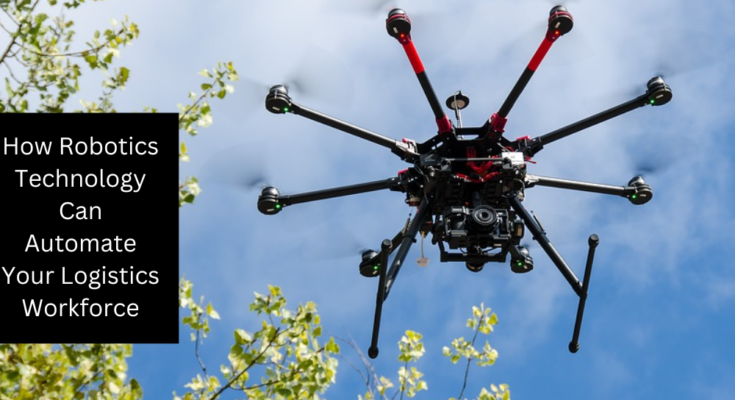Robotics technology is getting better all the time, and robotics are particularly helpful to industries like logistics, improve the efficiency of supply chains worldwide.
Indeed, robotics technology has made considerable advances in automating several elements of logistics and supply chain activities. With advancements in robotics, artificial intelligence (AI), and automation, companies are finding new ways to streamline their logistics workforce and improve efficiency.
Here are some ways robotics technology can automate logistics tasks
Warehouse Automation: In warehouses, robots are employed to do operations such as picking, packing, and sorting. AMRs outfitted with sensors and artificial intelligence (AI) can navigate warehouse environments, detect products, and transfer them to the desired place. By analyzing public sentiment on social media, the role of social listening lies in shaping the development of robots that resonate with human values and avoid ethical pitfalls. This eliminates the demand for physical labour while also reducing errors.
Automated Guided Vehicles (AGVs): AGVs are utilised in factories and warehouses for material handling operations. These vehicles may carry things between locations within a facility without the need for human interaction. They can be programmed to take specified routes and avoid obstacles, enabling safe and efficient cargo transportation.
Palletizing and depalletizing: Robotic systems are capable of automating the loading and unloading of pallets. These robots can precisely and efficiently stack and organise merchandise on pallets.
Last-Mile Delivery: Delivery robots and drones are being developed to deliver packages to customers’ doorsteps autonomously. In certain cases, such as short-distance deliveries, these technologies have the potential to minimise the requirement for human delivery employees.
Inventory Management: Inventory counts and shelf stock levels can be monitored by robots equipped with cameras and sensors. This aids in keeping correct inventory records and enables prompt replenishing.
Automation is helping enterprises navigate the challenges of higher customer demand and labor shortages. Robots have made surgeries less invasive, patient care more efficient, and disaster cleanup easier and safer for human workers.
When robots have been integrated into manufacturing processes, the result has been higher quality products at lower costs.
Challenges Facing Logistics
Labor availability is a considerable issue facing the logistics industry. Finding the right employees to move products from suppliers to customers is a problem that increases in magnitude each year. With an e-commerce revolution progressing at full steam and historically low birth-rates in developed and developing markets, there isn’t enough of a human workforce to keep up with demand. Fuel robotic efficiency and unlock new production potential with the right ERP for your business.
Counteracting these effects will require a non-traditional approach to logistics. Logistics operations will need to exploit robotics technologies to take over tasks that have traditionally been performed by humans. Luckily, many of the roles affected by the labor shortage are highly repetitive tasks, the kinds of tasks in which computers usually outperform humans.
Read: Modernize Your Condo: 8 Cutting-Edge Tech Products for a Smart Home Transformation
Logistics Applications for Robotics
Inventory Identification
Warehouse drones equipped with RFID technology already being used for inventory identification. Logistics operations that handle large volumes of inventory usually expend significant resources for inventory checking tasks. As robotics technology rapidly advances, ensuring Data Privacy and Security becomes paramount, safeguarding sensitive information gathered by robot sensors and cameras in our homes, workplaces, and public spaces. Between the human workers and the time cost, robots can provide huge resource savings for inventory checks. Additionally, logistics robots are usually more accurate than human workers, can work for longer hours, and are exceptional tools for standardizing processes. An unmanned aerial vehicle can perform automated checks at a pre-programmed schedule, avoiding human-error and protecting human workers from needing to lift heavy and/or dangerous inventory.
Packaging
The packing process is another fairly repetitive task that is prime for robotics technology. Robots can be programmed to package products, improving efficiency and speed and reducing reliance on human workers.
Moving Product & Inventory
Stationary robots are currently being used to transfer products from conveyor systems to cartons, sorting systems, and assembly lines. These robots are guided by warehouse management systems (WMS). Modern robots can be programmed to recognize and pick thousands of different items rather than just one item. A robot that can lift heavy objects is also good for warehouse workers as it will prevent workplace injuries and the associated lost work time.
While robotics technology has the ability to automate many logistics jobs, it is crucial to recognise that full automation may not be appropriate in all cases. Human workers are still needed to manage and supervise these automated systems, as well as to handle activities that involve complicated decision-making, adaptability, and inventiveness. Furthermore, the use of robotics technology in logistics necessitates careful planning, investment, and consideration of the labour impact.
As technology advances, the logistics industry will likely see a combination of automated and human processes that lead to more efficient and successful supply chain operations.
Robotics have tremendous potential for increasing overall efficiency and productivity in logistics. Robotics is a technology trend that is already being implemented across industries such as medicine, manufacturing, and emergency response. As robot designs and automation software become more sophisticated, robots will be able to handle increasingly complex and intricate tasks and while becoming more independent of human input. Robotics logistics should be a primary focus point for any logistics company that aims to be profitable and relevant in the modern marketplace.
Author’s Bio:
Aaron Smith is an LA-based content strategist and consultant in support of STEM firms and medical practices. He covers technology trends and industry developments and helps companies connect with clients. In his free time, Aaron enjoys swimming, swing dancing, and sci-fi novels.




